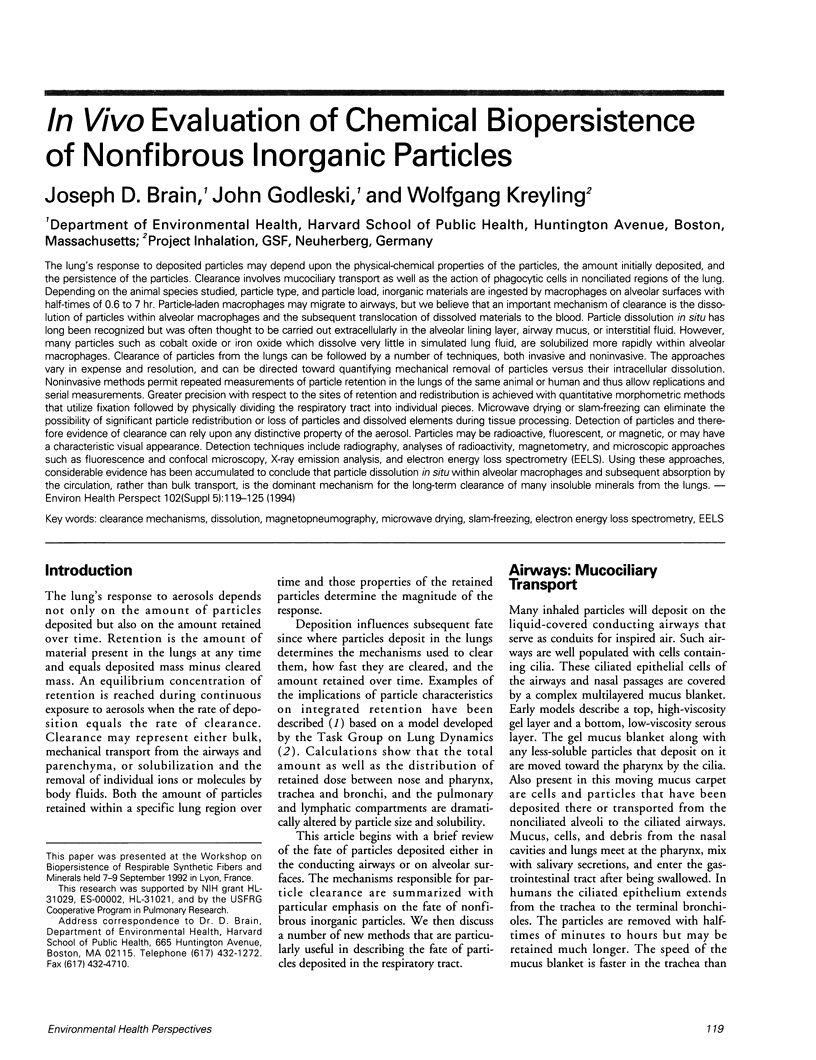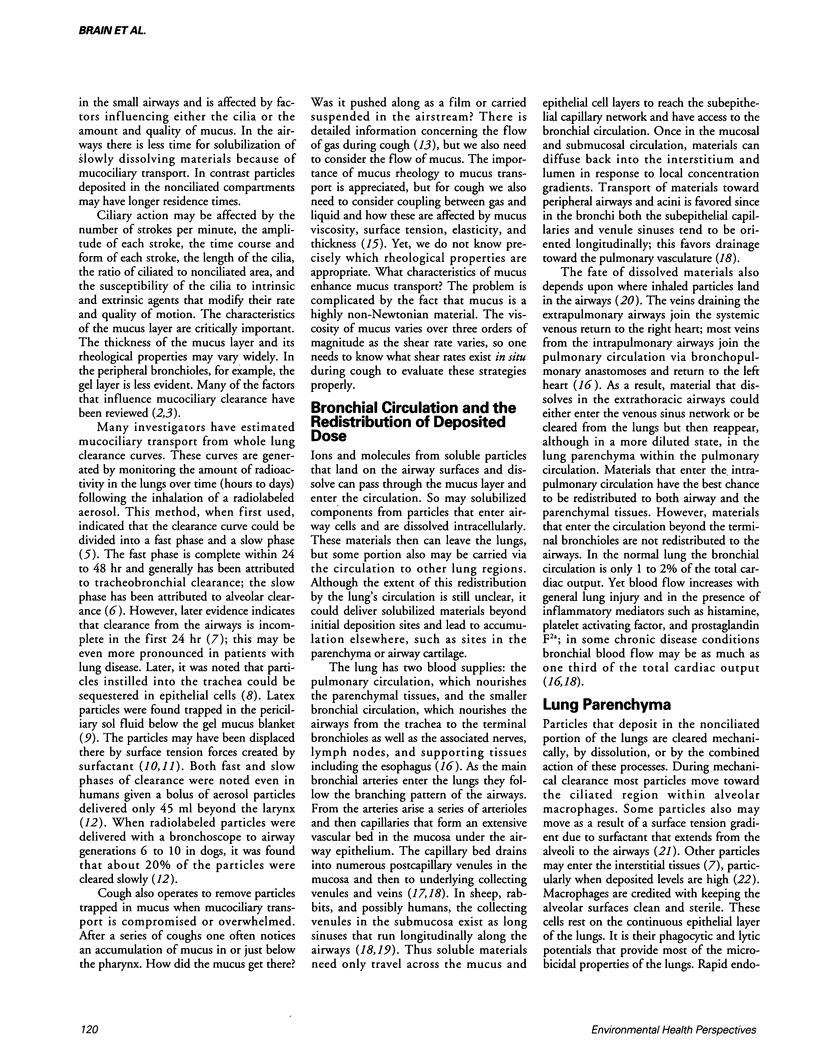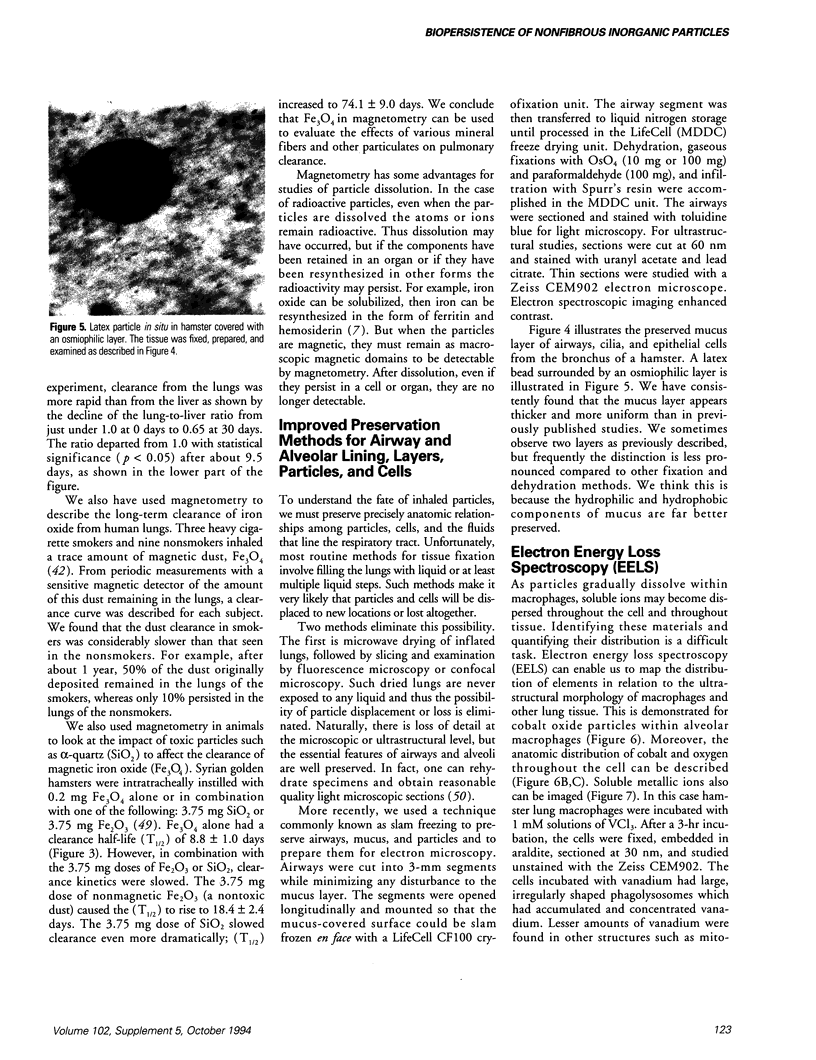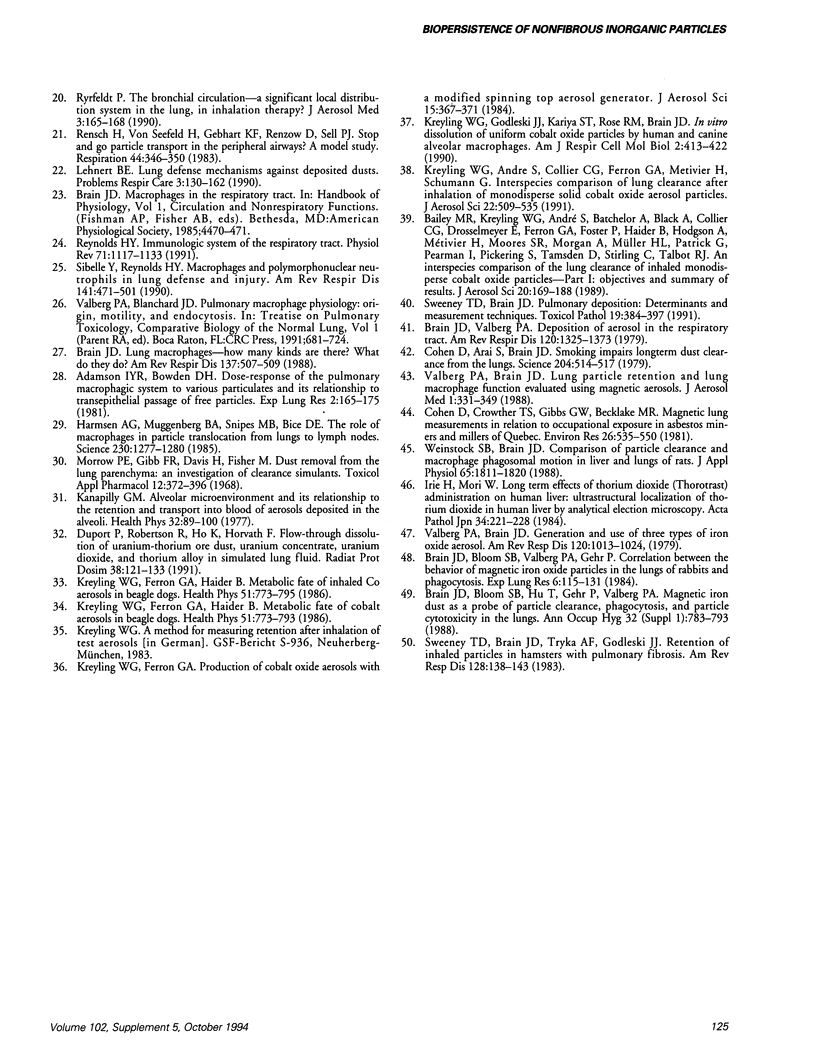Abstract
The lung's response to deposited particles may depend upon the physical-chemical properties of the particles, the amount initially deposited, and the persistence of the particles. Clearance involves mucociliary transport as well as the action of phagocytic cells in nonciliated regions of the lung. Depending on the animal species studied, particle type, and particle load, inorganic materials are ingested by macrophages on alveolar surfaces with half-times of 0.6 to 7 hr. Particle-laden macrophages may migrate to airways, but we believe that an important mechanism of clearance is the dissolution of particles within alveolar macrophages and the subsequent translocation of dissolved materials to the blood. Particle dissolution in situ has long been recognized but was often thought to be carried out extracellularly in the alveolar lining layer, airway mucus, or interstitial fluid. However, many particles such as cobalt oxide or iron oxide which dissolve very little in simulated lung fluid, are solubilized more rapidly within alveolar macrophages. Clearance of particles from the lungs can be followed by a number of techniques, both invasive and noninvasive. The approaches vary in expense and resolution, and can be directed toward quantifying mechanical removal of particles versus their intracellular dissolution. Noninvasive methods permit repeated measurements of particle retention in the lungs of the same animal or human and thus allow replications and serial measurements. Greater precision with respect to the sites of retention and redistribution is achieved with quantitative morphometric methods that utilize fixation followed by physically dividing the respiratory tract into individual pieces.(ABSTRACT TRUNCATED AT 250 WORDS)
Full text
PDF






Images in this article
Selected References
These references are in PubMed. This may not be the complete list of references from this article.
- ALBERT R. E., ARNETT L. C. Clearance of radioactive dust from the human lung. AMA Arch Ind Health. 1955 Jul;12(1):99–106. [PubMed] [Google Scholar]
- Adamson I. Y., Bowden D. H. Dose response of the pulmonary macrophagic system to various particulates and its relationship to transepithelial passage of free particles. Exp Lung Res. 1981 Aug;2(3):165–175. doi: 10.3109/01902148109052312. [DOI] [PubMed] [Google Scholar]
- Brain J. D., Bloom S. B., Valberg P. A., Gehr P. Correlation between the behavior of magnetic iron oxide particles in the lungs of rabbits and phagocytosis. Exp Lung Res. 1984;6(2):115–131. doi: 10.3109/01902148409087900. [DOI] [PubMed] [Google Scholar]
- Brain J. D. Lung macrophages: how many kinds are there? What do they do? Am Rev Respir Dis. 1988 Mar;137(3):507–509. doi: 10.1164/ajrccm/137.3.507. [DOI] [PubMed] [Google Scholar]
- Brain J. D., Valberg P. A. Deposition of aerosol in the respiratory tract. Am Rev Respir Dis. 1979 Dec;120(6):1325–1373. doi: 10.1164/arrd.1979.120.6.1325. [DOI] [PubMed] [Google Scholar]
- Brain J. D., Valberg P. A. Models of lung retention based on ICRP task group report. Arch Environ Health. 1974 Jan;28(1):1–11. doi: 10.1080/00039896.1974.10666424. [DOI] [PubMed] [Google Scholar]
- Cohen D., Arai S. F., Brain J. D. Smoking impairs long-term dust clearance from the lung. Science. 1979 May 4;204(4392):514–517. doi: 10.1126/science.432655. [DOI] [PubMed] [Google Scholar]
- Cohen D., Crowther T. S., Gibbs G. W., Becklake M. R. Magnetic lung measurements of relation to occupational exposure in asbestos miners and millers of Quebec. Environ Res. 1981 Dec;26(2):535–550. doi: 10.1016/0013-9351(81)90229-2. [DOI] [PubMed] [Google Scholar]
- Deffebach M. E., Charan N. B., Lakshminarayan S., Butler J. The bronchial circulation. Small, but a vital attribute of the lung. Am Rev Respir Dis. 1987 Feb;135(2):463–481. doi: 10.1164/arrd.1987.135.2.463. [DOI] [PubMed] [Google Scholar]
- Gore D. J., Patrick G. A quantitative study of the penetration of insoluble particles into the tissue of the conducting airways. Ann Occup Hyg. 1982;26(1-4):149–161. [PubMed] [Google Scholar]
- Harmsen A. G., Muggenburg B. A., Snipes M. B., Bice D. E. The role of macrophages in particle translocation from lungs to lymph nodes. Science. 1985 Dec 13;230(4731):1277–1280. doi: 10.1126/science.4071052. [DOI] [PubMed] [Google Scholar]
- Irie H., Mori W. Long term effects of thorium dioxide (thorotrast) administration on human liver. Ultrastructural localization of thorium dioxide in human liver by analytical electron microscopy. Acta Pathol Jpn. 1984 Mar;34(2):221–228. doi: 10.1111/j.1440-1827.1984.tb07551.x. [DOI] [PubMed] [Google Scholar]
- Kanapilly G. M. Alveolar microenvironment and its relationship to the retention and transport into blood of aerosols deposited in the alveoli. Health Phys. 1977 Feb;32(2):89–100. doi: 10.1097/00004032-197702000-00004. [DOI] [PubMed] [Google Scholar]
- Kreyling W. G., Ferron G. A., Haider B. Metabolic fate of inhaled Co aerosols in beagle dogs. Health Phys. 1986 Dec;51(6):773–795. doi: 10.1097/00004032-198612000-00007. [DOI] [PubMed] [Google Scholar]
- Kreyling W. G., Godleski J. J., Kariya S. T., Rose R. M., Brain J. D. In vitro dissolution of uniform cobalt oxide particles by human and canine alveolar macrophages. Am J Respir Cell Mol Biol. 1990 May;2(5):413–422. doi: 10.1165/ajrcmb/2.5.413. [DOI] [PubMed] [Google Scholar]
- Lippmann M., Albert R. E. The effect of particle size on the regional deposition of inhaled aerosols in the human respiratory tract. Am Ind Hyg Assoc J. 1969 May-Jun;30(3):257–275. doi: 10.1080/00028896909343120. [DOI] [PubMed] [Google Scholar]
- McDonald D. M. The ultrastructure and permeability of tracheobronchial blood vessels in health and disease. Eur Respir J Suppl. 1990 Dec;12:572s–585s. [PubMed] [Google Scholar]
- Morrow P. E., Gibb F. R., Davies H., Fisher M. Dust removal from the lung parenchyma: an investigation of clearance stimulants. Toxicol Appl Pharmacol. 1968 May;12(3):372–396. doi: 10.1016/0041-008x(68)90146-4. [DOI] [PubMed] [Google Scholar]
- Rensch H., von Seefeld H., Gebhardt K. F., Renzow D., Sell P. J. Stop and go particle transport in the peripheral airways? A model study. Respiration. 1983;44(5):346–350. doi: 10.1159/000194567. [DOI] [PubMed] [Google Scholar]
- Reynolds H. Y. Immunologic system in the respiratory tract. Physiol Rev. 1991 Oct;71(4):1117–1133. doi: 10.1152/physrev.1991.71.4.1117. [DOI] [PubMed] [Google Scholar]
- Satir P., Sleigh M. A. The physiology of cilia and mucociliary interactions. Annu Rev Physiol. 1990;52:137–155. doi: 10.1146/annurev.ph.52.030190.001033. [DOI] [PubMed] [Google Scholar]
- Schürch S., Gehr P., Im Hof V., Geiser M., Green F. Surfactant displaces particles toward the epithelium in airways and alveoli. Respir Physiol. 1990 Apr;80(1):17–32. doi: 10.1016/0034-5687(90)90003-h. [DOI] [PubMed] [Google Scholar]
- Sibille Y., Reynolds H. Y. Macrophages and polymorphonuclear neutrophils in lung defense and injury. Am Rev Respir Dis. 1990 Feb;141(2):471–501. doi: 10.1164/ajrccm/141.2.471. [DOI] [PubMed] [Google Scholar]
- Sorokin S. P., Brain J. D. Pathways of clearance in mouse lungs exposed to iron oxide aerosols. Anat Rec. 1975 Mar;181(3):581–625. doi: 10.1002/ar.1091810304. [DOI] [PubMed] [Google Scholar]
- Sweeney T. D., Brain J. D. Pulmonary deposition: determinants and measurement techniques. Toxicol Pathol. 1991;19(4 Pt 1):384–397. doi: 10.1177/0192623391019004-107. [DOI] [PubMed] [Google Scholar]
- Sweeney T. D., Brain J. D., Tryka A. F., Godleski J. J. Retention of inhaled particles in hamsters with pulmonary fibrosis. Am Rev Respir Dis. 1983 Jul;128(1):138–143. doi: 10.1164/arrd.1983.128.1.138. [DOI] [PubMed] [Google Scholar]
- Valberg P. A., Brain J. D. Generation and use of three types of iron-oxide aerosol. Am Rev Respir Dis. 1979 Nov;120(5):1013–1024. doi: 10.1164/arrd.1979.120.5.1013. [DOI] [PubMed] [Google Scholar]
- Weinstock S. B., Brain J. D. Comparison of particle clearance and macrophage phagosomal motion in liver and lungs of rats. J Appl Physiol (1985) 1988 Oct;65(4):1811–1820. doi: 10.1152/jappl.1988.65.4.1811. [DOI] [PubMed] [Google Scholar]








